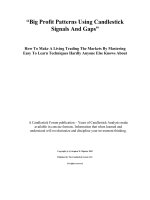Sentence patterns using to infinitives
Bạn đang xem bản rút gọn của tài liệu. Xem và tải ngay bản đầy đủ của tài liệu tại đây (11.1 KB, 1 trang )
Sentence patterns using to-infinitives
A knowledge common sentence patterns is essential to use English correctly. In a sentence, words are arranged
in a particular order. This order in which words appear in a sentence is called the pattern of that sentence. There
are several sentence patterns in English. If you are serious about learning English, you must have a decent
understanding of all of these patterns.
All of you must be familiar with the pattern subject + verb + object. This is one of the most fundamental sentence
patterns in English. As you know, the object of a verb is usually a noun or a pronoun. Several other words and
structures that act like nouns can also be used as objects. For example, infinitives can be used as objects. In this
lesson we will learn about some sentence patterns with to-infinitives.
Subject + verb + question word + to-infinitive
In this structure the phrase containing the question word and the to-infinitive acts as the direct object of the verb.
I don’t know what to do. (Here the phrase what to do is the object of the verb know.)
We have been told where to stay. (Here the phrase where to stay is the object of the verb told.)
I’ll enquire how to reach there. (Here the phrase how to reach there is the object of the verb enquire.)
Let’s decide when to start.
Subject + verb + indirect object + question word + to-infinitive
The verbs used in this structure take two objects – a direct object and an indirect object. The indirect object is
usually a person. The direct object is a phrase containing a question word and a to-infinitive.
I taught him how to answer that question. (Here the pronoun him is the indirect object of the verb taught whereas
the phrase how to answer that question is the direct object.)
She told me what to do.
Tell me how to operate the washing machine.
Can you advice the boy how to behave?
Stay on top of your writing! Download our grammar guide from www.englishgrammar.org to stay up-to-date.
Powered by TCPDF (www.tcpdf.org)









